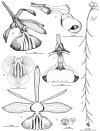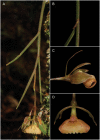A new species of Epidendrum L. (Orchidaceae) of pendulous habit from Peru
- PMID: 34776732
- PMCID: PMC8580958
- DOI: 10.3897/phytokeys.184.70844
A new species of Epidendrum L. (Orchidaceae) of pendulous habit from Peru
Abstract
A new species of Epidendrum L. from northern Peru is described, illustrated, and compared with related species. This new species belongs to the Laxicaule Group and shares morphological characteristics with Epidendrumlaxicaule D.E. Benn & Christenson but differs in the shape and length of the dorsal sepal; the shape of the petals and the lip, ribs position of the lip, shape of the vesicle formed between the ovary and the column as well as the section of the stem.
AbstractSe describe, ilustra y compara una nueva especie de Epidendrum L. del norte de Perú con otras especies relacionadas. Esta nueva especie pertenece al Grupo Laxicaule y comparte características morfológicas con Epidendrumlaxicaule D.E. Benn & Christenson pero difiere en la forma y longitud del sépalo dorsal; la forma de los pétalos y del labio, la posición de las costillas del labio, la forma de la vesícula formada entre el ovario y la columna así como la sección del tallo.
Keywords: Cajamarca; Epidendroideae; San Ignacio; endemic; epiphyte; neotropic.
Luis Ocupa Horna, Eric Hágsater, Marco M. Jiménez.
Figures





References
-
- Bennett DE, Christenson EA. (1998) New species of Peruvian Orchidaceae V. Lindleyana 13: 42–45.
-
- Chase MW, Cameron KM, Freudenstein JV, Pridgeon AM, Salazar GA, van den Berg C, Schuiteman A. (2015) An updated classification of Orchidaceae. Botanical Journal of the Linnean Society 177(2): 151–174. 10.1111/boj.12234 - DOI
-
- Granados Mendoza C, Jost M, Hágsater E, Magallón S, van den Berg C, Moriarty Lemmon E, Lemmon AR, Salazar GA, Wanke S. (2020) Target Nuclear and Off-Target Plastid Hybrid Enrichment Data Inform a Range of Evolutionary Depths in the Orchid Genus Epidendrum. Frontiers in Plant Science 10: e1761. 10.3389/fpls.2019.01761 - DOI - PMC - PubMed
-
- Hágsater E. (1985) Towards an understanding of the genus Epidendrum. In Proceedings of the Eleventh World Orchid Conference. American Orchid Society, Miami, Florida, 195–201.
-
- Hágsater E, Huayta A. (2018) Epidendrummegalopentadactylum Hágsater & Huayta. In: Hágsater E, Santiago E (Eds) The Genus Epidendrum, Part 12, Icones Orchidacearum 16(2): e1683. https://www.herbarioamo.org/index_archivos/Fascicle16_2.pdf
LinkOut - more resources
Full Text Sources
